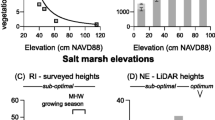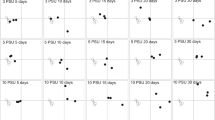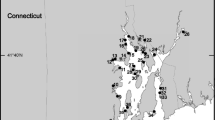Abstract
Recent hydrological disturbances, including flooding, dry-season streamflow, and drought, greatly altered coastal wetland habitats in sourthern California. At Tijuana Estuary, a six-year study of salt-marsh vegetation patterns during these rare conditions documented substantial temporal variability in plant growth and distribution. Important to cordgrass (Spartina foliosa Trin.) dynamics were the amount and timing of streamflows, which reduced soil salinity and alleviated stresses on plant growth. Poorest growing conditions occurred in 1984 when both river and tidal flows were lacking; soils had low moisture and extreme salinities (avg.=104‰ in September). Plant stress was documented in 1984 as high mortality (62% fewer stems than in 1983) and reduced height (19% less than in 1983). Cordgrass height was greatest in 1980 following winter flooding (20% increase over 1979); densities were greatest in 1983 with summer freshwater influxes (60% increase over 1982). A carbon allocation model is proposed to explain the varied responses.
Similar content being viewed by others
Literature Cited
Caswell, H. 1982. Life history theory and the equilibrium status of populations.Am. Nat. 120:317–339.
Connell, J. H., andW. P. Sousa. 1983. On the evidence needed to judge ecological stability or persistence.Am. Nat. 121:789–824.
Covin, J. 1984. The Role of Nitrogen in the Growth and Distribution ofSpartina foliosa at Tijuana Estuary, California. M.S. Thesis, San Deigo State Univ., San Diego.
Dayton, P., andM. Tegner. 1984. Catastrophic storms, El Nino, and patch stability in a southern California kelp bed.Science 224:283–285.
Dayton, P., V. Currie, T. Gerrodette, B. Keller, R. Rosenthal, andD. Ven Tresca. 1984. Patch dynamics and stability of some California kelp communities.Ecol. Monogr. 54:253–289.
International Boundary and Water Commission. 1983. Western Water Bull. Flow of the Colorado R. and Other Western Boundary Streams and Related Data. El Paso, 93 p.
Long, S., andC. Mason. 1983. Saltmarsh Ecology. Blackie and Son, London.
Onuf, C. P., M. L. Quammen, G. P. Shaffer, C. H. Peterson, J. W. Chapman, J. Cermak, andR. W. Holmes. 1978. An analysis of the values of central and southern California coastal wetlands, p. 186–199.In P. E. Greeson, J. R. Clark, and J. E. Clark (eds.), Wetland Functions and Values: The State of Our Understanding. American Water Research Association, Minneapolis.
Pryde, P. 1976. Chapter 8: Water supply for the county, p. 103–120.In. P. R. Pryde (ed.), San Diego, an Introduction to the Region. Kendall/Hunt, Dubuque.
Sousa, W. P. 1984. The role of disturbance in natural communities.Ann. Rev. Ecol. Syst. 15:353–391.
U.S. Geological Survey. 1937–1980. Water Supply Papers 1937–1970, and Water Resources Data for California, 1971–1980. Washington, D.C.
Valiela, I. 1984. Marine Ecological Processes. Springer-Verlag, New York.
Veblen, T. T., andD. H. Ashton. 1978. Catastrophic influences on the vegetation of the Valdivian Andes, Chile.Vegetatio 36:149–167.
West, D. C., H. H. Shugart, Jr., andD. Botkin (eds.). 1981. Forest Succession: Concepts and Application. Springer-Verlag, New York.
Winfield, T. 1980. Dynamics of Carbon and Nitrogen in a Southern California Salt Marsh. Ph.D. Dissertation, Univ. of California, Riverside, and San Diego State Univ., San Diego.
Zedler, J. B. 1982. The Ecology of Southern California Coastal Salt Marshes: A Community Profile. U.S. Fish and Wildlife Service, Biological Services Program, Washington, D.C. FWS/OBS-81/54.
Zedler, J. B. 1983. Freshwater impacts in normally hypersaline marshes.Estuaries 6:346–355.
Zedler, J. B., and P. A. Beare. In press. Temporal variability of salt marsh vegetation: the role of lowsalinity gaps and environmental stress.In D. Wolfe (ed.), Estuarine Variability. Academic Press, New York.
Zedler, J. B., T. P. Winfield, andP. Williams. 1980. Detritus utilization byMytilus edulis.Oecologia 44: 236–240.
Zedler, P. H., C. R. Gautier, andG. S. McMaster. 1983. Vegetation change in response to extreme events: the effect of a short interval between fires in California chaparral and coastal scrub.Ecology 64: 809–818.
Author information
Authors and Affiliations
Rights and permissions
About this article
Cite this article
Zedler, J.B., Covin, J., Nordby, C. et al. Catastrophic events reveal the dynamic nature of salt-marsh vegetation in Southern California. Estuaries 9, 75–80 (1986). https://doi.org/10.2307/1352195
Received:
Accepted:
Issue Date:
DOI: https://doi.org/10.2307/1352195




